



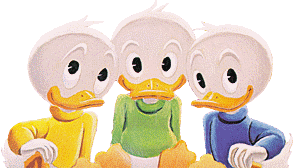
Born in Oregon in 1901, Carl Barks was destined to be one of the
most popular comic book artists and storytellers in the world.
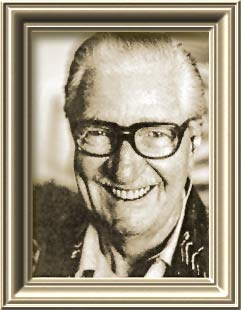
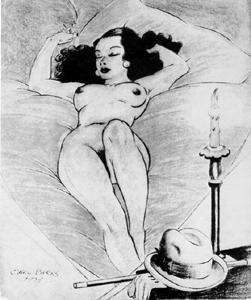 Arguably, he still is.
And yet why haven't you heard of him? He was of the generation
of Constantin Alajalov, Edward Ardizzone, Boris Artzybasheff, Walt Disney, Robert Fawcett,
Al Hirschfeld,
Ray Prohaska, Saul Tepper, and Sulamith
Wulfing - a generation of great talent and great change.
Arguably, he still is.
And yet why haven't you heard of him? He was of the generation
of Constantin Alajalov, Edward Ardizzone, Boris Artzybasheff, Walt Disney, Robert Fawcett,
Al Hirschfeld,
Ray Prohaska, Saul Tepper, and Sulamith
Wulfing - a generation of great talent and great change.
Barks' artistic training consisted of an incomplete mail order
course from the Landon School and the ever-changing lessons of
the Sunday comics sections of the newspaper. He learned his lessons
well, but it wasn't until 1928 that he sold his first cartoons
to the Calgary Eye-Opener, a Capt. Billy's Whizbang
imitator out of Minneapolis. A few sales to Judge helped
convince him that his dream of being an illustrator had merit.
In 1930, he moved to Minneapolis and worked as a staff artist
and eventually the de facto editor of the Eye-Opener.

a sample of an Eye-Opener cartoon circa 1928
from The Unexpurgated Carl Barks
Hamilton Comics
In 1935 he applied for a job at the Walt Disney animation studio. He was hired as an in-betweener. That's an artist who has the thankless job of drawing the intervening animation frames that make the action flow smoothly between two drawings that were done by a REAL animator. Needless to say, he was not happy with the work. He had spent five years practically writing and drawing a whole magazine at the Eye-Opener and the menial task of in-betweening must have chafed. After six months, he submitted a story idea for a Donald Duck cartoon (the barber chair climax of Modern Inventions - released in 1937) and was promoted to the story department. There he worked for six years, contributing ideas and sketches to dozens of cartoons. The elegant nude above was drawn during this period.
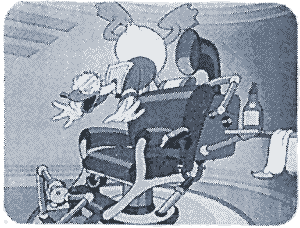
Barks' first story sale - Modern Inventions
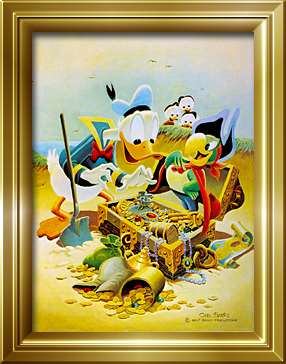 Disney
had licensed Oscar Lebeck of Western Publishing to produce comic
books featuring his characters. During one visit to the studio,
Lebeck had found a script for an unrealized animated cartoon about
Donald and a pirate treasure. He convinced Barks, Bob Clark and
Jack Hanna to turn it into a strip for his Four Color comic book
series of one shots. It was published as Donald Duck Finds
Pirates' Gold in Four Color Comics #9, August 1942.
(At left is a modern recreation of the cover to that issue.) Carl
Barks had found his metier.
Disney
had licensed Oscar Lebeck of Western Publishing to produce comic
books featuring his characters. During one visit to the studio,
Lebeck had found a script for an unrealized animated cartoon about
Donald and a pirate treasure. He convinced Barks, Bob Clark and
Jack Hanna to turn it into a strip for his Four Color comic book
series of one shots. It was published as Donald Duck Finds
Pirates' Gold in Four Color Comics #9, August 1942.
(At left is a modern recreation of the cover to that issue.) Carl
Barks had found his metier.
In 1942, he quit Disney. The air-conditioned offices of the Disney Studios and Barks' allergies and sinuses were no match for each other. Now he wanted to develop a comic book or comic strip character of his own. He was raising chickens in arid San Jacinto when Lebeck decided to add new stories to his flagship Disney title, Walt Disney's Comics and Stories. He was currently reprinting material from the Disney newspaper strips that were quite popular at the time. He asked Barks to draw the new strips. Carl said yes and history was made.
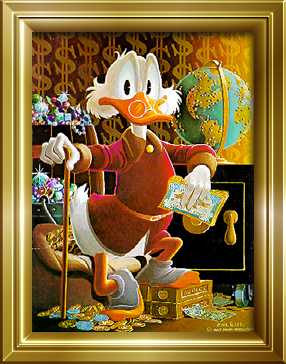 Literally.
Up to that point, Donald Duck was a vehicle for the Disney animators.
When Barks began his 23 year stint on the comic book, he had three
nephews and Daisy, the girl friend. The nephews were fairly recent
additions, created during Barks' stint in the story department
at the studio, but beyond that, characters and locales were conjured
up to service the gags of the next cartoon. Carl proceeded to
flesh out the Duck family.
Literally.
Up to that point, Donald Duck was a vehicle for the Disney animators.
When Barks began his 23 year stint on the comic book, he had three
nephews and Daisy, the girl friend. The nephews were fairly recent
additions, created during Barks' stint in the story department
at the studio, but beyond that, characters and locales were conjured
up to service the gags of the next cartoon. Carl proceeded to
flesh out the Duck family.
In quick succession he created Duckburg and populated it with
Uncle Scrooge, The Beagle Boys, Gladstone Gander, Gyro Gearloose,
Grandma Duck, Gus Goose, Magica DeSpell, and the entire organization
of Junior Woodchucks. The dynamics of Donald Duck's life were
invented by Carl Barks in the pages of Walt Disney's Comics
and Stories, Donald Duck Comics, and eventually, in
1952, in Uncle Scrooge Comics. The money bin, the lucky
dime, the mythic Junior Woodchuck Guide - all flowed from Barks.
He wrote and drew all his stories.
 |
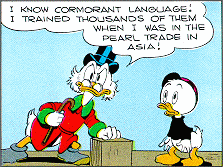 |
But, during the entire span of his career, he never signed a single story. It was simply not done. Yet, anyone who read the Disney comics knew that there was a "good duck artist" and then there was "everyone else." Chances are, if you read those comics in the 40's, 50's and 60's (or the reprints later on), you remember some of the stories. There was the one about the square eggs, the Terries and the Firmies, Scrooge in the Yukon, the Harpies, etc. Chances are good, if you do remember any of them, you remember the Barks stories. I do. I still remember sitting in David Butler's basement on Gaylord Avenue in Pittsburgh reading his comics. The only specific comic books I remember are Barks' ducks, Stanley's Little Lulu and Russ Manning's Brothers of the Spear in the back of the Tarzan comics.
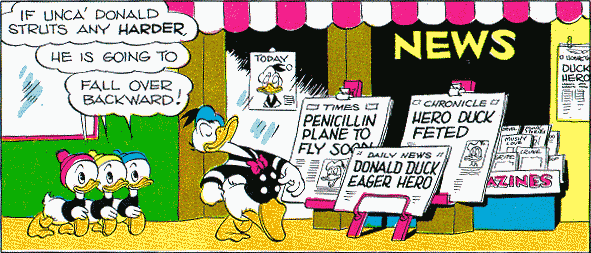
Barks' approach to creating comics was to never write down to his audience. In the panel above, from 1944's Frozen Gold, 'penicillin' and 'feted' could easily have been 'medicine' and 'honored,' but Barks didn't feel the need for condescension. And there are even points of interest in the titles of the magazines on the newsstand. Gripe, Crime, Mushy Love, and Punk Stories would give any reader, regardless of age, a chuckle or two.
With rare exceptions, Barks wrote and drew a monthly 10 page story for Comics and Stories until 1965 as well as most of the Uncle Scrooge stories which were often longer, more complex adventures. There were mystery stories, westerns, adventure stories, even political and other satires all masquerading as comic book comedies. He was inventive, clever, dynamic and, above all, an artist of the first rank. Just look at the expression on Huey's face above when Scrooge tells him that he speaks cormorant.
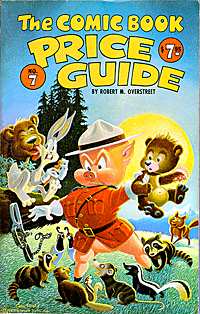 It
was Bill Spicer who first discovered that Barks was the "good
duck artist" and sent him his first fan letter. He was so
used to anonymity, he thought it was a joke. Western had never
told him that he regularly got fan mail and that there had even
been a reader rebellion in 1950 when his work load forced him
to skip several issues of his regular Comics and Stories
strips. He never knew he was famous. Anonymous, but famous none
the less.
It
was Bill Spicer who first discovered that Barks was the "good
duck artist" and sent him his first fan letter. He was so
used to anonymity, he thought it was a joke. Western had never
told him that he regularly got fan mail and that there had even
been a reader rebellion in 1950 when his work load forced him
to skip several issues of his regular Comics and Stories
strips. He never knew he was famous. Anonymous, but famous none
the less.
After he was "discovered" in the early 60's, he began to reminisce and socialize with fans. He was awarded the first Shazam in the 'Best Humor Writer in Comic Books' category in 1971. He recreated many of his most famous comic covers in oil for fans in the 1970's until Disney revoked their permission in 1976. (The Donald and Scrooge above are samples.) He attended a comic convention in Boston in 1976 and was the subject of a major retrospective in (as well as painting the cover for) the 1977 Comic Book Price Guide.
He inspired the creation of Another Rainbow, a company dedicated to his work. They reprinted the entire Barks oeuvre in 30 hardback volumes presented in ten slipcased sets dubbed The Carl Barks Library. They published The Fine Art of Walt Disney's Donald Duck in a handsome, slip-cased, limited signed edition of 1875 copies. It features stunning color reproductions of each of the 122 duck paintings that he did for fans.
My friend Don Rosa, a fellow comics collector and historian, actually sold his family business and "retired" when given the opportunity to draw Uncle Scrooge. Yes, the comic books are still being published. Not in the U.S. No, we're too sophisticated for comics about ducks, but everywhere else in the world. And everywhere else they are wildly successful. Read Don's tribute to Barks from the September, 2000 issue of The Comics Journal. He makes an airtight case for Barks being the most influential storyteller of the 20th century.
Carl Barks died in August of the year 2000. He was 99.
 To learn more about Carl Barks, see:
To learn more about Carl Barks, see:
| The Who's Who of American Comic Books | Jerry Bails and Hames Ware, Bails, 1973 |
| Carl Barks—From Burbank to Calisota | E. Barbara Boatner, The Comic Book Price Guide, Overstreet, 1976 |
| The Fine Art of Walt Disney's Donald Duck | E. Barbara Boatner/Bruce Hamilton, Another Rainbow, 1981 |
| Carl Barks 1901-2000 | various, The Comics Journal, September 2000 |
| The Vadeboncoeur Collection of Knowledge | Jim Vadeboncoeur, Jr. 2000 |
|
Illustrations are copyright by their
respective owners. This page written, designed & © 2000 by Jim Vadeboncoeur, Jr. Updated 2011. |
